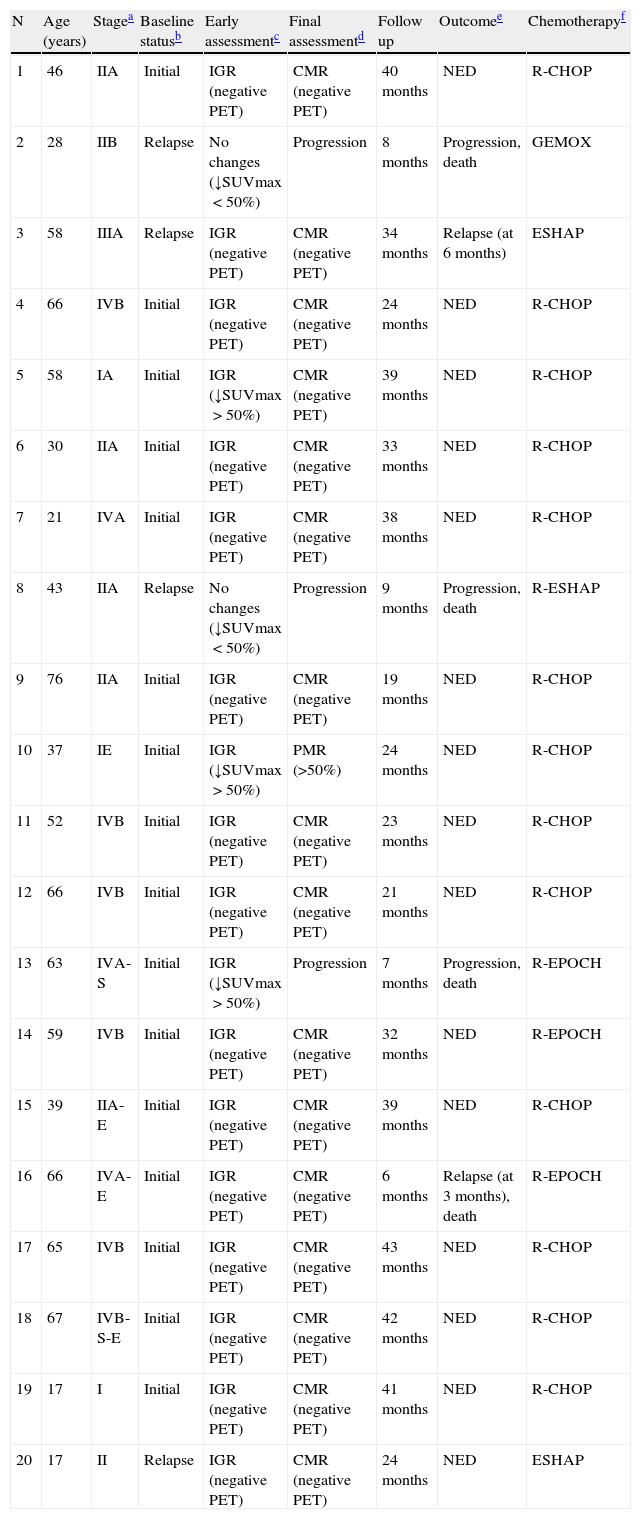To assess the role of FDG-PET/CT performed after the first cycles of chemotherapy in the prediction of response to treatment in patients with diffuse large B-cell lymphoma.
Material and MethodsTwenty patients (mean age: 48 years) were included, 16 initial staging and 4 relapse. All patients underwent PET/CT at three times: (1) baseline, (2) after 1–3 cycles of chemotherapy (early response assessment), and (3) end of treatment (evaluation of final response). Early PET/CT findings were correlated to the end-treatment PET/CT and follow-up. The evaluation of the response was established according to the decrease in uptake of the lesions (SUVmax). In the early assessment, a good response indicator (GRI) was obtained when the lesion disappeared or had more than 50% reduction in SUVmax. At the end of the treatment, a complete metabolic response (CMR) was determined in negative PET scans. Follow-up was superior to 19 months and final outcome was established as progression/relapse or no evidence of disease (NED).
ResultsAt the early treatment evaluation, 16/16 patients of initial staging (100%) and 2/4 of relapse (50%) achieved GRI. At the end of treatment evaluation, 14/16 patients of initial staging with GRI achieved CMR and 1/16 PMR: 14 were alive with NED in the follow-up while 1 relapsed. In the second group, 2/2 patients with GRI achieved CMR (100%): 1 continued with NED in the follow-up and another relapsed.
ConclusionFDG-PET/CT after the first cycles of chemotherapy is useful to monitor treatment due to its high negative predictive value (87.5%), using it to modify treatment early in the non-responders.
Valorar la utilidad de la PET-TC con FDG tras los primeros ciclos de quimioterapia en la predicción de la respuesta al tratamiento en pacientes con linfoma B difuso de célula grande.
Material y MétodosSe incluyeron 20 pacientes (edad media: 48), 16 en la estadificación inicial y 4 por recidiva. La PET-TC se realizó en tres tiempos: 1) Basal, 2) Tras el primer-tercer ciclo (valoración de respuesta precoz), y 3) Al finalizar el tratamiento (valoración de respuesta final). Los hallazgos de la valoración precoz fueron correlacionados con la valoración final y el seguimiento. La valoración de la respuesta se estableció según la disminución de la captación de las lesiones (SUVmax). En la valoración precoz el indicador de buena respuesta (IBR) fue la reducción del SUVmax > 50% o la desaparición. Al final del tratamiento se determinó la respuesta metabólica completa (RMC) en ausencia de focos. El seguimiento fue superior a los 19 meses, estableciendo progresión/recidiva o sin evidencia de enfermedad (SEE).
ResultadosLa valoración precoz fue IBR en 16/16 pacientes de estadificación inicial (100%) y en 2/4 de recidiva (50%). Al final del tratamiento, en el primer grupo 14/16 pacientes con IBR consiguieron RMC y 1/16 RMP; 14 continuaron SEE y uno recidivó. En el segundo grupo 2/2 pacientes con IBR consiguieron RMC; uno continuó SEE y otro recidivó.
ConclusionLa PET-TC tras los primeros ciclos de quimioterapia es útil para monitorizar el tratamiento debido a su elevado valor predictivo negativo (87,5%), modificando la terapia precozmente en los no respondedores.
Artículo

Revista Española de Medicina Nuclear e Imagen Molecular (English Edition)
Comprando el artículo el PDF del mismo podrá ser descargado
Precio 19,34 €
Comprar ahora









